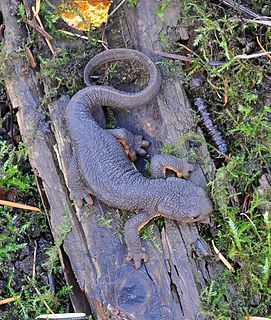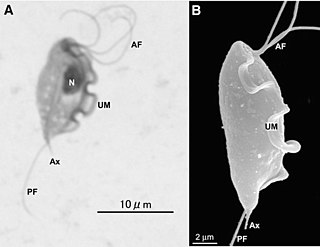Related Research Articles

The smooth newt, northern smooth newt or common newt is a species of newt. It is widespread in much of Eurasia, from the British Isles to Siberia and northern Kazakhstan, and introduced to Australia. Individuals are brown with an orange to white, spotted underside and reach a length of 8–11 cm (3.1–4.3 in), with males being larger than females. The skin is dry and velvety while the newts live on land but becomes smooth when they migrate into water for breeding. Breeding males develop a more vivid colour pattern and a conspicuous skin seam (crest) on their back.

Salamandridae is a family of salamanders consisting of true salamanders and newts. Salamandrids are distinguished from other salamanders by the lack of rib or costal grooves along the sides of their bodies and by their rough skin. Their skin is very granular because of the number of poison glands. They also lack nasolabial grooves. Most species of Salamandridae have moveable eyelids but lack lacrimal glands.

Monogeneans are a group of ectoparasitic flatworms commonly found on the skin, gills, or fins of fish. They have a direct lifecycle and do not require an intermediate host. Adults are hermaphrodites, meaning they have both male and female reproductive structures.
In evolutionary biology, an evolutionary arms race is a struggle between competing sets of co-evolving genes, traits, or species, that develop adaptations and counter-adaptations against each other, resembling an arms race. These are often described as examples of positive feedback. The co-evolving gene sets may be in different species, as in an evolutionary arms race between a predator species and its prey, or a parasite and its host. Alternatively, the arms race may be between members of the same species, as in the manipulation/sales resistance model of communication or as in runaway evolution or Red Queen effects. One example of an evolutionary arms race is in sexual conflict between the sexes, often described with the term Fisherian runaway. Thierry Lodé emphasized the role of such antagonistic interactions in evolution leading to character displacements and antagonistic coevolution.

The fire belly newts or fire newts are a genus (Cynops) of newts native to Japan and China. All of the species show bright yellow or red bellies, but this feature is not unique to this genus. Their skin contains a toxin that can be harmful if ingested.
The Japanese fire belly newt is a species of newt in the family Salamandridae endemic to Japan. It is commonly confused with the Chinese fire belly newt due to similarities in coloring and size, and most newts sold as Japanese fire belly newts are likely to be the more commonly collected Chinese fire belly newt instead. It is extremely toxic - fatal within 6 hours - to humans and other animals.

The genus Taricha consists of four species of highly poisonous newts in the family Salamandridae. Their common name is Pacific newts, sometimes also western newts or roughskin newts. The four species within this genus are the California newt, the rough-skinned newt, the red-bellied newt, and the sierra newt, all of which are found on the Pacific coastal region from southern Alaska to southern California, with one species possibly ranging into northern Baja California, Mexico.

The rough-skinned newt or roughskin newt is a North American newt known for the strong toxin exuded from its skin.

The California newt or orange-bellied newt, is a species of newt endemic to California, in the Western United States. Its adult length can range from 5 to 8 in. Its skin produces a potent toxin.

The Mount Jefferson Wilderness is a wilderness area located on and around Mount Jefferson in the central Cascade Range of Oregon in the United States. It is situated where the Willamette, Deschutes, and Mount Hood National Forests meet. Mount Jefferson Wilderness is the second most visited Oregon wilderness area after the Three Sisters Wilderness.

Planorbella is a genus of freshwater air-breathing snails, aquatic pulmonate gastropod mollusks in the family Planorbidae, the ram's horn snails, or planorbids, which all have sinistral, or left-coiling, shells.

Paramesotriton, also known as warty newts or Asian warty newts, is a genus of salamanders in the family Salamandridae. The genus is found in southwestern and southern China and in northern Vietnam. Most of the species are endemic to China, and the majority of them have been described recently, since 2008. The genus includes both pond and stream dwellers.

Glossiphoniidae are a family of freshwater proboscis-bearing leeches. These leeches are generally flattened, and have a poorly defined anterior sucker. Most suck the blood of freshwater vertebrates like amphibians, crocodilians and aquatic turtles, but some feed on invertebrates like oligochaetes and freshwater snails instead. Although they prefer other hosts, blood-feeding species will opportunistically feed from humans.

A newt is a salamander in the subfamily Pleurodelinae. The terrestrial juvenile phase is called an eft. Unlike other members of the family Salamandridae, newts are semiaquatic, alternating between aquatic and terrestrial habitats. Not all aquatic salamanders are considered newts, however. More than 100 known species of newts are found in North America, Europe, North Africa and Asia. Newts metamorphose through three distinct developmental life stages: aquatic larva, terrestrial juvenile (eft), and adult. Adult newts have lizard-like bodies and return to the water every year to breed, otherwise living in humid, cover-rich land habitats.
The Crater Lake newt or Mazama newt, Taricha granulosa mazamae, is a subspecies of the rough-skinned newt. Its type locality is Crater Lake, Oregon. Similar newts have been found in Alaska, but their identity is unclear.
Megalobatrachonema is a nematode genus. Species of this genus are parasites of a number of amphibians including the rough-skinned newt.
Cephalouterina is a genus of trematodes within the family Lecithodendriidae under the order Plagiorchiida. Individuals of this genus are known to use amphibian hosts.
Cephalouterina decamptodoni is a species of trematodes within the family Lecithodendriidae under the order Plagiorchiida. This species is sometimes known to use amphibian hosts.

Tritrichomonas is a genus of single celled flagellated parasitic excavates, some of whose species are known to be pathogens of the bovine reproductive tract as well as the intestinal tract of felines.
Cosmocercoides is a genus of nematode within the order Ascaridida. Nematodes within the genus Cosmocercoides have been found as parasites within the rough-skinned newt, Taricha granulosa. Cosmocercoides includes the following species:
References
- ↑ Uniprot Taxonomy: Genus Karotomorpha
- ↑ C. Michael Hogan (2008) Rough-skinned Newt ("Taricha granulosa"), GlobalTwitcher, ed. N. Stromberg
| | This heterokont-related article is a stub. You can help Wikipedia by expanding it. |
| | This article related to a parasitic member of the SAR supergroup is a stub. You can help Wikipedia by expanding it. |